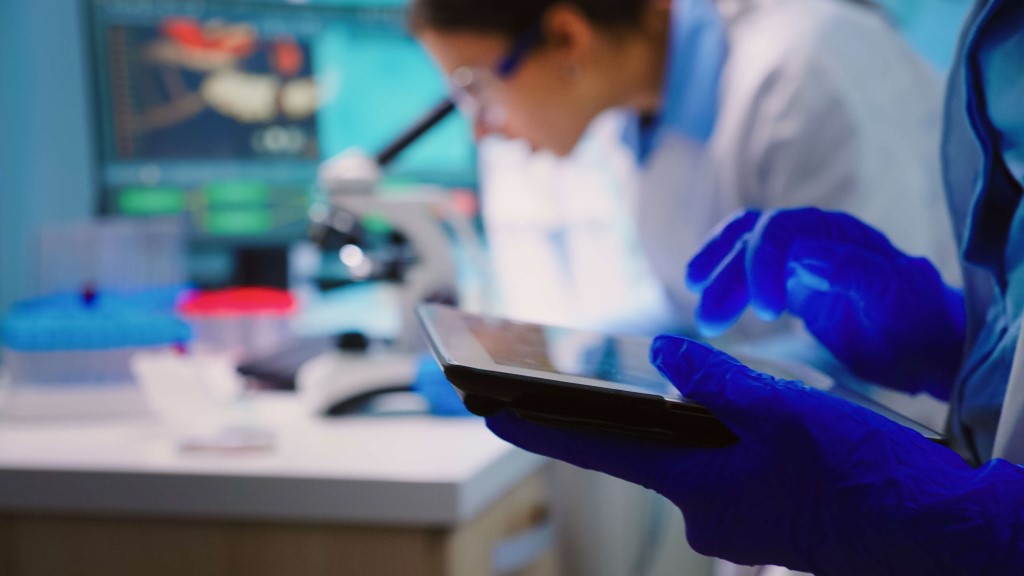In today’s fast-paced world, embracing digitalization has become essential for laboratories to enhance efficiency, accuracy, and collaboration. By transitioning from traditional analog methods to digital solutions, laboratories can unlock a plethora of benefits, ranging from streamlined data management to accelerated research and innovation. This comprehensive guide will walk you through ten essential steps to successfully digitalize your laboratory, enabling you to leverage cutting-edge technologies and optimize your scientific workflows. Whether you’re a small-scale research facility or a large-scale industrial laboratory, this guide will provide you with invaluable insights to navigate the digital transformation journey and unlock the full potential of your laboratory operations. Let’s embark on this transformative voyage and discover how to revolutionize your laboratory through digitalization.
What is a Digital Lab?

A digital lab can be defined as a virtual or cloud-based environment that integrates advanced technologies and tools to facilitate experimentation, analysis, and collaboration in a wide range of disciplines. It serves as a centralized hub where researchers, scientists, engineers, artists, and professionals from diverse domains can access and leverage powerful computational resources, software applications, and datasets. The digital lab creates a flexible and scalable ecosystem that enables efficient research and development processes, fostering innovation and discovery.
Key Features and Functionalities of Digitalizing Laboratories
Data Management and Analysis: Digital labs offer robust systems for managing and analyzing vast amounts of data, allowing researchers to store, organize, and process information efficiently. These platforms often employ data visualization techniques, machine learning algorithms, and statistical tools to extract valuable insights from complex datasets.
Simulation and Modeling: Through virtualization and simulation capabilities, digital labs enable scientists and engineers to create accurate and realistic models of physical phenomena. This allows for the exploration of various scenarios, optimization of experimental parameters, and prediction of outcomes, reducing the need for costly and time-consuming physical experiments.
Collaboration and Communication: Digital labs foster collaboration by providing shared workspaces, real-time communication channels, and collaborative tools. Researchers and professionals from different geographical locations can collaborate seamlessly, exchange ideas, share data, and collectively work on projects, accelerating the pace of research and innovation.
Experimentation and Prototyping: Digital labs offer a platform for designing and conducting experiments in a virtual environment. Researchers can create digital prototypes, simulate experiments, and analyze results, enabling rapid iteration and refinement of ideas. This capability is particularly valuable in fields such as materials science, chemistry, and product development.
10 Steps to Digitalize Your Laboratory
Identify Goals and Objectives
Before initiating any digitalization efforts, clearly define your laboratory’s goals and objectives. Determine what specific areas you want to improve, such as data management, workflow automation, or equipment integration. Setting clear goals will guide your digitalization strategy and help you measure success.
Assess Current Processes and Technologies
Conduct a thorough assessment of your laboratory’s current processes, technologies, and data management systems. Identify any bottlenecks, manual tasks, or areas prone to errors. This assessment will help you prioritize areas that require immediate attention and ensure that your digitalization efforts address the most critical needs.
Build a Digitalization Team
Assemble a dedicated team responsible for overseeing the digitalization project. Include members from different departments, such as laboratory management, IT, and relevant scientific experts. This interdisciplinary team will bring diverse perspectives and ensure successful implementation.
Invest in Laboratory Information Management System (LIMS)
A Laboratory Information Management System (LIMS) is the backbone of a digitalized laboratory. It enables seamless data capture, management, and analysis. Choose a LIMS that aligns with your laboratory’s needs, such as sample tracking, instrument integration, and compliance requirements. Ensure the selected LIMS is scalable and adaptable to future technological advancements.
Automate Workflows and Processes
Identify repetitive and time-consuming tasks that can be automated. From sample registration to data analysis, leverage automation tools and software to streamline processes, reduce human error, and improve overall efficiency. This may involve integrating laboratory instruments, implementing robotic systems, or utilizing workflow management software.
Implement Electronic Laboratory Notebooks (ELNs)
Replace traditional paper-based lab notebooks with electronic laboratory notebooks. ELNs offer enhanced data security, collaboration features, and easier data retrieval. Researchers can efficiently record and share experimental details, observations, and results, promoting seamless collaboration and knowledge sharing.
Ensure Data Security and Compliance
With digitalization comes the need for robust data security measures. Implement data encryption, access controls, and regular backups to protect sensitive data from unauthorized access or loss. Compliance with industry standards, such as Good Laboratory Practices (GLP) or ISO certifications, should also be a priority.
Enable Remote Access and Collaboration
Digitalization enables remote access and collaboration, which is especially valuable in today’s interconnected world. Implement cloud-based solutions and virtual collaboration platforms that allow researchers, stakeholders, and clients to access and share data securely from anywhere. This fosters collaboration and accelerates decision-making processes.
Embrace Data Analytics and AI
Leverage the power of data analytics and artificial intelligence (AI) to extract valuable insights from vast amounts of data. Implement data visualization tools and AI algorithms to identify patterns, trends, and correlations in your laboratory data. This can lead to better decision-making, predictive analytics, and optimization of laboratory processes.
Provide Training and Support
Digitalization requires a cultural shift and proper training for laboratory staff to adapt to new technologies and workflows. Offer comprehensive training programs to ensure employees are proficient in using digital tools and understand the benefits of digitalization. Additionally, establish ongoing technical support channels to address any concerns or issues that may arise.
To Wrap Up!
In conclusion, digitalizing laboratories has become increasingly important in the modern era, offering numerous benefits such as improved efficiency, accuracy, and data management. By embracing technology, laboratories can streamline workflows, enhance collaboration, and unlock new opportunities for scientific advancement. The future of laboratories lies in embracing digital solutions, and this guide serves as a valuable resource to navigate this transformative process effectively. With careful planning, thorough implementation, and ongoing optimization, laboratories can harness the power of digitalization to drive innovation, improve outcomes, and pave the way for a more connected and data-driven scientific landscape.